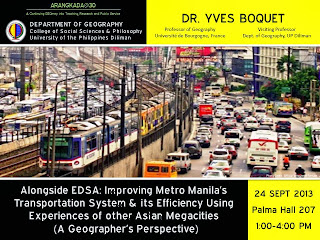Everyone is invited to
The Geography Lab Core Group Technical
Colloquia’s
Spatial Technologies in Advancing
Research Techniques (START)
Date: September 12, 2013
Time: 5:30-7:30pm
Venue:
Palma Hall 207, Roxas Avenue, UP Diliman, Quezon City
Topics:
Session 1: Modeling Geographic
Distributions with MaxEnt
Discussant: Mart Geronia, MS Geology
student
MaxEnt (Maximum Entropy) is a java-based
free software that is capable of producing ecological models of the geographic
distributions of species based on variables using the maximum entropy method of
probability. The maximum entropy method ensures that the probability
distribution the model estimates is closest to uniform and the most spread out,
subject to the constraints set by the variables; i.e., the model assumes that a
species can be found uniformly across space subject to the constraints set.
This software is written by Steven Phillips, Miro Dudik and Rob Schapire, with
support from AT&T Labs-Research, Princeton University, and the Center for
Biodiversity and Conservation, American Museum of Natural History. This
software generates models of a species’ geographic distribution using the
constraint features or the environmental variables describing the background landscape
and by using the collection of presence-only data of the distribution of the
species in question. It can also integrate both categorical and continuous data
for the variables and will not diminish its capability to produce a good model.
Aside from its application in modeling
the geographic distributions of species habitats in ecology and biogeography,
the maximum entropy method has been used in the fields of linguistics (for
natural language processing), economics (mainly in game theory), climate research
(modeling a species habitat based on future climatic scenarios), and in political
science and sociology (application of ecological inferences or drawing
conclusions about individual behavior from aggregate data).
Session 2: Grid Analysis and Display
System (GrADS) for Earth Science Data Processing and Visualization
Discussant: Robert Badrina, MS
Meteorology student
Grid analysis and display system (GrADS)
is an open source, interactive desktop tool that is used for easy access,
manipulation and visualization of earth science data. It can handle various
data file format such as binary (stream or sequential), GRID, NetCDF, HDF and
BUFR (for station data). GrADS has been implemented worldwide and currently
being used by researchers around the globe, it has an online group forum where
community of users exchange information about the software.
Outputs of climate models (Regional
Climate Model (RegCM) and Global Climate Model) are
can be utilized using GrADS. It uses
four convention environmental dimensions: longitude,
latitude, vertical level and time. There
are also data available for free such as resources
from the Tropical Rainfall Measuring
Mission (TRMM) which can provide rainfall estimates
that can be processed using GrADS. Data
can be displayed using variety of graphical
technique: line and bar graphs, scatter
plots, smoothed contours, shaded contours,
streamlines, wind vectors, grid boxes,
shaded boxes and station model plots. GrADS is
supported by the Institute of Global
Environment and Society dedicated for climate research
in the service of the society.
S.T.A.R.T. aims to provide a venue for
young researchers to present various techniques for visualizing and analyzing
spatial data using recent technologies and data processing software to aid in further
enhancing social science research methodologies.
As spatial information is integral in
addressing the pressing environmental and social issues we deal with at both
local and global scales, these colloquia seek to facilitate exchanges among young
academics on the potentials of available technologies to deliver useful
information to the public for more informed decision-making.
The Lab Core Group of the UP Department
of Geography was formed in 2009 by student
volunteers who wanted to help manage the
then small GIS laboratory of the institution.
Beyond serving as the lab technical
assistance team, it initiated other projects such as the Geography1 Open Lab which rovided
introductory training on Google Earth image interpretation, GIS, and GPS, and
the drafting of he GIS laboratory user guidelines and its file management and
data security scheme.




